 CAES News
CAES News
Solar Well Pump
University of Georgia researchers are hoping solar-powered wells will help preserve water quality and cattle health on isolated Georgia cattle farms.





